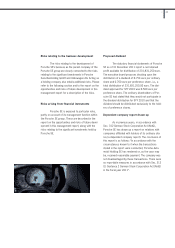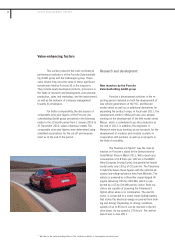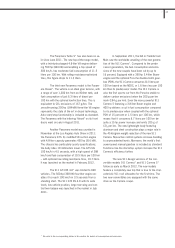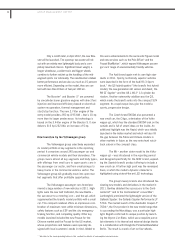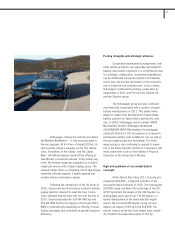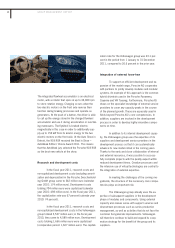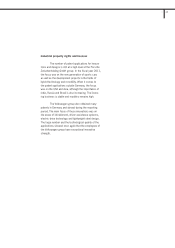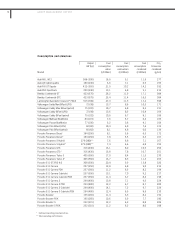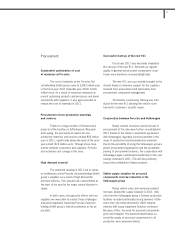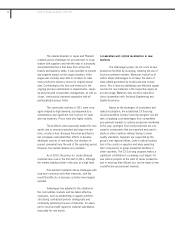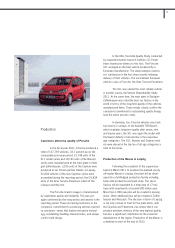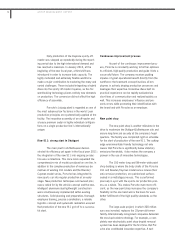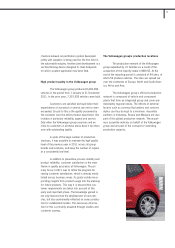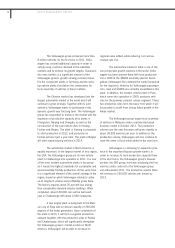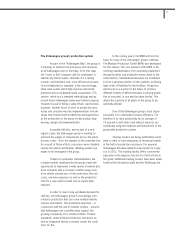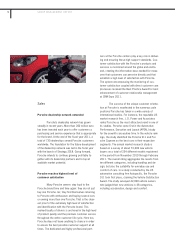Porsche 2011 Annual Report Download - page 72
Download and view the complete annual report
Please find page 72 of the 2011 Porsche annual report below. You can navigate through the pages in the report by either clicking on the pages listed below, or by using the keyword search tool below to find specific information within the annual report.
The natural disasters in Japan and Thailand
created special challenges for procurement. In coop-
eration with suppliers and with the help of a promptly
assembled task force that drew from across the
brands and business fields, it was possible to prevent
any negative impact on the supply situation. Volks-
wagen was recently even able to increase its maxi-
mum production volumes versus its original annual
plan. Contributing to this first and foremost is the
ongoing process optimization in requirements, capac-
ity and procured components management, as well as
closer, continuously improved integration with all
participating business fields.
The commodity markets in 2011 were once
again shaped by high demand, accompanied by a
simultaneous and significant rise in prices for input
and raw materials. Prices were also highly volatile.
These effects were especially evident for rare
earths due to several production and export restric-
tions, mostly in Asia. Because American and Austra-
lian companies intensified their efforts to develop
additional sources of rare earths, the situation im-
proved somewhat near the end of the reporting period.
However, the market remains very unstable.
As in 2010, the prices for crude oil-based
materials also rose in the first half of 2011, although
the market stabilized later in the year at a high level.
Procurement reacted to these challenges with
long-term contracts and other measures, with the
result that effects on business activities were largely
avoided.
Volkswagen has adapted to the situation in
the commodities markets and has taken effective
measures, such as establishing a supplier portfolio,
structuring contractual periods strategically and
continually optimizing the use of materials, for exam-
ple for steel and with regard to material substitution,
especially for rare earths.
Localization and radical localization in new
markets
The Volkswagen group can cut costs at new
production facilities by localizing, meaning the use of
local procurement markets. Moreover, radical local-
ization allows Volkswagen to increase the share of
value added generated by locally procured compo-
nents. This is done by identifying cost-effective supply
sources for raw materials in the respective region at
an early stage. Material costs are thus reduced in
close cooperation with Technical Engineering and
Quality Assurance.
Based on the strategies of localization and
radical localization, the established C3 Sourcing
(Cost-Competitive Country Sourcing) program has the
task of applying cost advantages from competitive
procurement markets to vehicle production worldwide.
In this way, synergies from local production are con-
veyed to components that are exported and used in
plants in other countries without having to lower
quality standards. Suppliers are supported by the
group’s own regional offices, both in radical localiza-
tion in the country in question and when exporting
their components to group production facilities in
other countries. The C3 Sourcing program makes a
significant contribution to achieving cost targets for
new vehicle projects at the start of series production
and to ensuring that efficient use can be made of new
cost-effective procurement markets.
GROUP MANAGEMENT REPORT72



